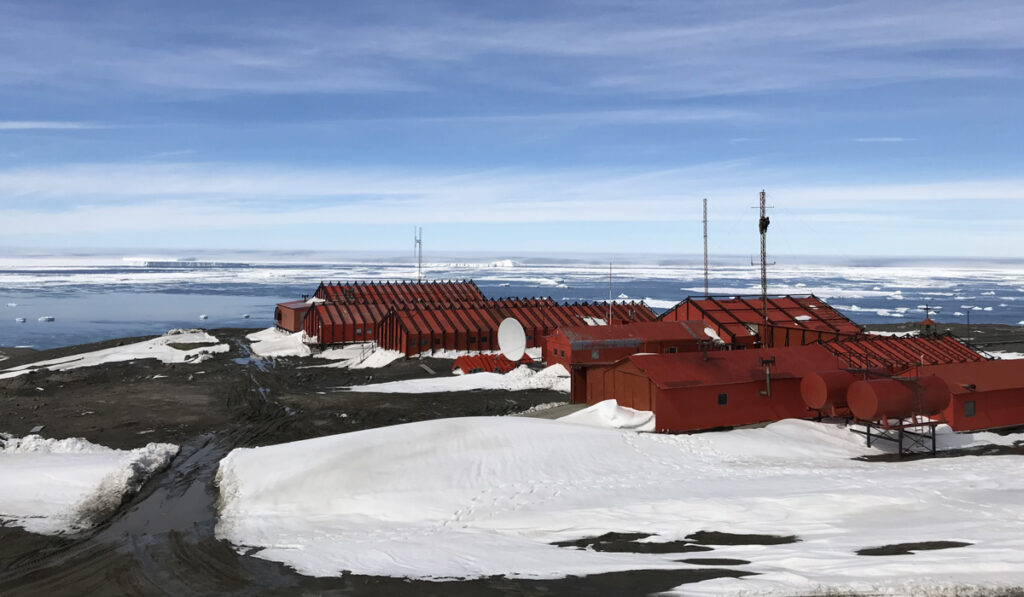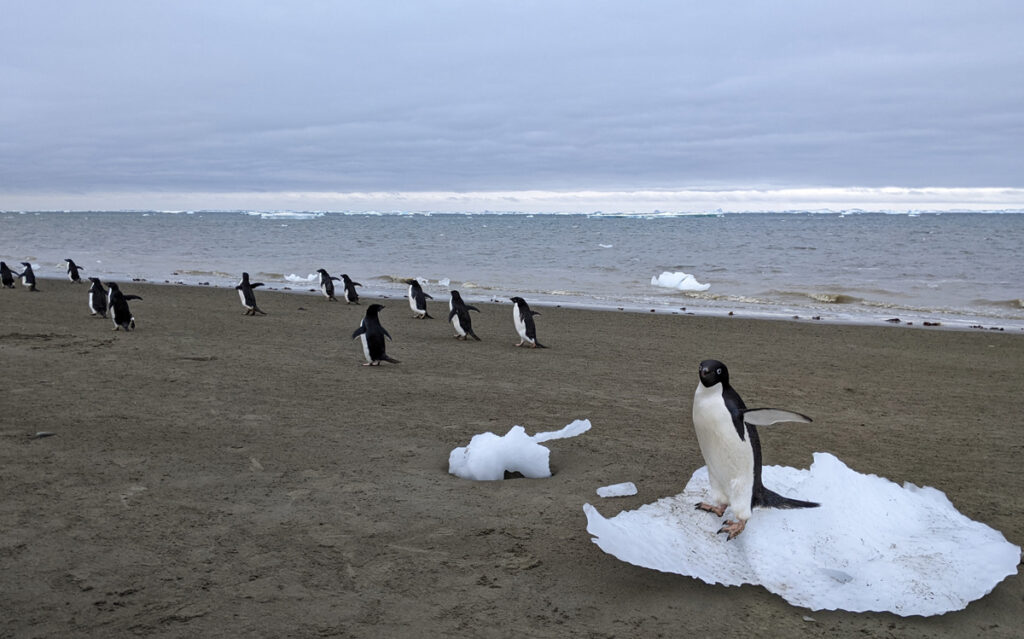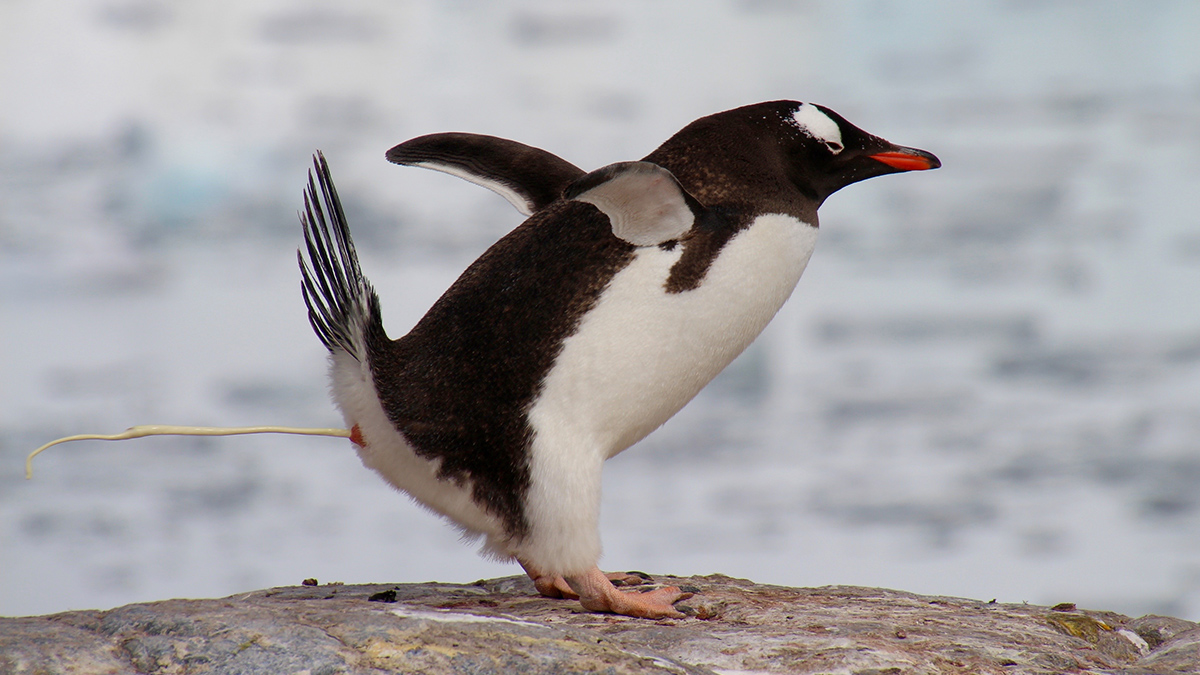Ammonia released from penguin poop helps produce cloud-seeding aerosols in Antarctica, which can affect local climate by increasing cloud formation. The discovery came when scientists measured air downwind of two colonies of Adélie penguins on the tip of the Antarctic Peninsula.
Penguin poop emitted 100–1,000 times baseline levels of ammonia. New aerosol particles formed when that ammonia mixed with sulfur compounds from marine phytoplankton. The research was published in Communications Earth & Environment.
“This shows a deep connection between the natural ecosystem emissions and atmospheric processes, where emissions from both local seabird and penguin colonies and marine microbiology have a synergistic role that can impact clouds and climate,” said Matthew Boyer, a doctoral student in atmospheric science at the University of Helsinki in Finland and lead author of the study.
Strong Whiffs of Ammonia
Although only trace amounts of ammonia exist in Earth’s atmosphere, scientists have found that when it mixes with certain sulfur compounds it creates ultrafine particles (<0.1 micrometer in size). Those aerosols can grow into cloud condensation nuclei.
“Aerosol particles are necessary for cloud formation; liquid water will not condense to form cloud droplets without the presence of aerosol particles,” Boyer explained.
The presence of these aerosols is especially important in pristine environments such as Antarctica that have low background levels of cloud-forming particles.
“The new particle formation process doesn’t strictly need ammonia to proceed, but ammonia boosts the rate of the process considerably—up to 1,000 times faster,” Boyer said. Gases emitted from natural sources such as penguins and the ocean are an important source of aerosols in the region, he added.
But the extremely low concentrations of gaseous ammonia, combined with the remoteness of Antarctica, have made understanding this cloud formation pathway challenging.
To tackle this problem, the researchers set up atmospheric samplers on the ground near Argentina’s Marambio Station, located on Seymour Island near the northernmost tip of the Antarctic Peninsula. Two large colonies of Adélie penguins nested a few kilometers away, one with about 30,000 breeding pairs and another with roughly 15,000 penguin pairs, as well as 800 cormorant pairs.

From 10 January to 20 March 2023 (during austral summer), the team measured concentrations of ammonia, fine aerosol particles, and larger cloud condensation nuclei, as well as relative abundance of certain elements, cloud droplet distribution, and other atmospheric properties. By late February, the penguins left their breeding grounds and traveled to their wintering site, enabling the researchers to analyze the atmosphere with and without the birds present.
When wind blew air from the nesting grounds to the monitoring station, the team found that the penguin colonies emitted up to 13.5 parts per billion of ammonia, more than 1,000 times more than background levels without poop. However, when winds blew in from the sea, the Southern Ocean was a “negligible” source of ammonia.
“The footprint of ammonia emissions from penguins may cover more area of coastal Antarctica than indicated by the location of their colonies alone.”
Even after the penguins migrated, the poop they left behind continued to elevate ammonia to 100 times higher than background levels, which was the most surprising discovery for Boyer.
“This means that the footprint of ammonia emissions from penguins may cover more area of coastal Antarctica than indicated by the location of their colonies alone,” he said.
The team found that 30 times more aerosol particles formed when gaseous ammonia mixed with sulfuric gases released by marine phytoplankton. When that combination then mixed with dimethylamine gas, also emitted by penguin poop, aerosol formation increased 10,000-fold.
Gaseous ammonia lasts only a few hours in the atmosphere, but the aerosol particles it creates can survive for several days. Under the right wind conditions, those particles could travel out over the Southern Ocean and generate clouds where cloud condensation nuclei sources are limited.

The new results align with past research that examined the impact of Arctic seabirds on atmosphere and climate. They also agree with past laboratory and modeling studies of Antarctic cloud formation, which have been considered more reliable in the past than in situ measurements.
“Measuring ammonia on its own under normal circumstances can be tricky,” said Greg Wentworth, an atmospheric scientist with the government of Alberta in Canada who was not involved with the new research. “To do all the sophisticated measurements required to tease apart the details of new particle formation is remarkable, especially since they did this at the ends of the Earth!”
Penguin Feedback Loops
“How remarkable is it that emissions from penguin poop and phytoplankton can kick-start chemistry in the atmosphere that can alter clouds and affect climate?”
“This study provides the most compelling evidence to date that ammonia and sulfur compounds…are an important source of cloud condensation nuclei during summertime in Antarctica,” Wentworth added. “How remarkable is it that emissions from penguin poop and phytoplankton can kick-start chemistry in the atmosphere that can alter clouds and affect climate?”
The polar regions are experiencing dangerous levels of warming, and more cloud cover can help cool things down…sometimes. Higher concentrations of aerosol particles tend to create thicker, low-atmosphere clouds that are more reflective and can cool the surface, Boyer said. Thinner clouds high in the atmosphere tend to trap heat and warm the surface.
Understanding whether seabirds generate aerosols at a consistent, high-enough rate to cool local climate would require more atmospheric monitoring and climate modeling, he added.
A connection between penguins and their environment means that when one is threatened, both feel the impacts. As climate change warms the polar regions and endangers the species that live there, the loss of those species could reduce cloud cover and further accelerate warming.
“It’s important to understand how ecosystems, especially sensitive ones in remote regions, will respond to climate change,” Wentworth said. “It’s doubly important to understand those changes when components of those ecosystems also impact climate change.”
“The more we understand about specific processes that impact ecosystems and climate change, the better we can predict and adapt to change,” Wentworth said.
—Kimberly M. S. Cartier (@astrokimcartier.bsky.social), Staff Writer

